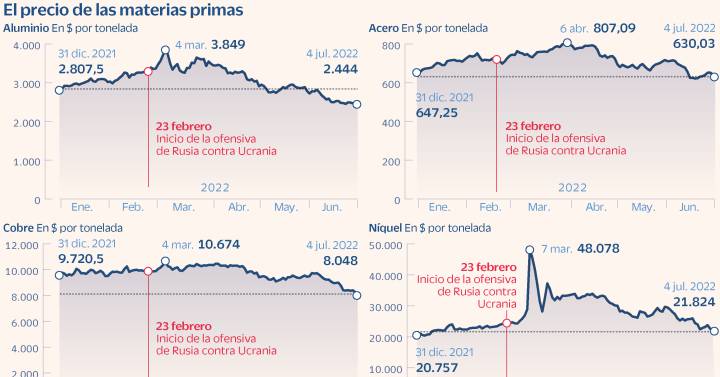The prices of industrial raw materials are beginning to show worrying signs that point to a global recession. So far this year, the price of the aluminum has plummeted 13%, that of the copper 17% and that of the steel bars 18%, which indicates that demand is beginning to weaken.
Unlike what happens with energy raw materials, such as oil or natural gas, which continue to record highs due to the distortions caused by the war in Ukraine and the sanctions against Russia, industrial raw materials have been showing notable weakness for several months.
Yesterday, a report by the US bank Goldman Sachs revised downwards its forecasts for the price of hierro. Its experts believe that an economic deterioration in the world economy and China’s problems in completely getting rid of Covid-19 will end up reducing prices.
Other materials used in various industries, such as zinc the tin or the lead also accumulate significant falls in 2022.
The average cost of freight begins to fall
containers. The Freightos Baltic Index measures global container shipping rates, calculating spot rates for 40-foot (12-meter) containers on 12 global trade routes. This index, after reaching its maximum in September 2021, began a slow decline. So far this year, freight prices have fallen by 30%, reflecting weak demand.
Baltic Dry Index. The oldest and most popular freight index is also showing signs of moderation in recent weeks. Having reached its decade high in September 2021, the Baltic Dry Index started to fall sharply. In the last six weeks, the index shows a price drop of 30%.
To these setbacks, those of other more specific materials are also added. This is the case of wood planks, widely used in the construction sector in the United States, and which this year have depreciated by 52%. Or that of cellulose pulp, which has fallen by 7% this year.
The only positive part of all these corrections is that they will help limit inflation. But the bad part is the origin of the falls. A year ago, inflation began to skyrocket in the United States (after years of low interest rates and huge aid to cope with the effects of the 2020 pandemic). The Federal Reserve was slow to act, and when it did so by announcing rate hikes, it was already too late. Now, it has declared war on price increases, even at the cost of sacrificing economic growth. More and more economists predict that by the end of this year or the beginning of next, the US economy will enter a recession.
Other agricultural raw materials, such as Palm oil or the cotton have also begun to correct and accumulate in 2022 falls of 18% and 8%, respectively.
Helima Croft, Global Head of Commodities Strategy at RBC Capital Markets explains that “fears of a global recession are now setting the pace for markets, eclipsing even fears of runaway inflation”.
All in all, these falls in the prices of industrial and agricultural raw materials have not been accompanied, for the time being, by a clear change in the trend in oil or natural gas. Experts point out that the markets for these fuels are too altered and conditioned by the future of the war in Ukraine and the sanctions.

